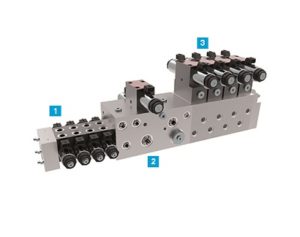The demands placed on a modern hydraulic system in mobile working machines are varied, but important considerations include reliability, energy efficiency, ease of maintenance and a compact design.

Control blocks from Argo-Hytos include 1. Standard sandwich valves, 2. Central inlet section and 3. Sections from modular systems.
Control blocks from Argo-Hytos, Zug, Switzerland, combine standard and application-specific components and provide the flexibility necessary for efficient systems. Different designs, sizes and control strategies can be combined to optimize performance in specific applications.
They include standard sandwich valves, a central inlet section, and sections from modular systems. The control block is divided into three sections:
1. Standard catalog products for flow rates up to 25 l/min.
2. Application-specific control block with screw-in and flangeable valves, including UNF 3/4 and 7/8, and ISO-4401.
3. Sandwich sections from modular systems, nominal size 6, which can include an LS-connection, directional control valves (DCVs) and proportional control valves (PCVs), with and without pressure compensators.
In general, there are two types of hydraulic power “consumers” in mobile machines: those that are actuated and operated frequently or permanently during operation; and others that are used rarely or sporadically, for instance when actuating movements.
Only in rare cases are the permanently operated consumers supplied with maximum pressure at all times, so an LS circuit in conjunction with a control pump for these functions is often recommended. By using control pumps, energy consumption can be brought much closer to the “real” demand of the function. The precondition for this is created by the sandwich section (item 3 described above) of the control block, which taps the LS signal, limits it upwards and also relieves it if necessary. Main pressure protection can also be integrated in the inlet section.
Another example includes a control block with four groups of valves:
1. DCVs and PCVs.
2. Pilot-operated check valves and overcenter valves.
3. Screw-in valves 3/4 and 7/8 UNF.
4. Directional control valves 4/2 and 4/3.

This design features 1. DCVs and PCVs, 2. Pilot-operated check valves and overcenter valves, 3. Screw-in valves 3/4 and 7/8 UNF, and 4. Directional control valves 4/2 and 4/3.
In section 1, simple throttle control is realized by means of DCVs. The actuating and auxiliary functions supplied here are used sporadically, so an LS circuit is not mandatory. Savings in terms of cost, weight and space are paramount. Directional control valve functions have been configured in addition to the usual locking and pressure functions from the company’s catalog. Quick and subsequent adjustments are also possible during the course of testing, by changing the tie rods and sandwich valves, letting engineers easily adapt both the number of consumers and the functionality.
Switching from the LS system to the constant pressure system takes place in the central inlet section by means of a 3/4 UNF screw-in valve. By operating a 3/2-way valve, the control pump is supplied with control pressure, it opens, and it supplies the control block with the preset maximum pressure. The pressures of the LS sections and the constant-pressure sections can be adjusted independently of each other. An electrically proportional adjustment is easily feasible by replacing the valves. Parallel operation of the two sides is equally available as a priority circuit for one of the two functional units, which is implemented in the central inlet section.
In most cases, the central inlet section is a customer-specific aluminum control block, which is designed according to system conditions. In addition to mounting options, the size, position and arrangement of the connections are determining factors in the design of the inlet section. Engineers, thus, are free to fully consider the customer requirements.
Argo-Hytos relies on tried-and-tested principles and schematics regarding design and functionality. For years, these design concepts have been used successfully in a wide variety of mobile equipment. The further development and adaptation of the switching logic behind the LS switching and “conditioning” of the LS signal permits various operating versions: manual, electrical, with electro-sensor control, or hydraulically automatic.
The functional principles and design options presented here are suitable for a wide range of agricultural and construction machines, such as sprayers, balers, combine harvesters, forage harvesters, reach stackers, potato and beet harvesters, planting and seed drills, to name only a few.
ARGO-HYTOS
www.argo-hytos.com
Filed Under: Mobile Hydraulic Tips